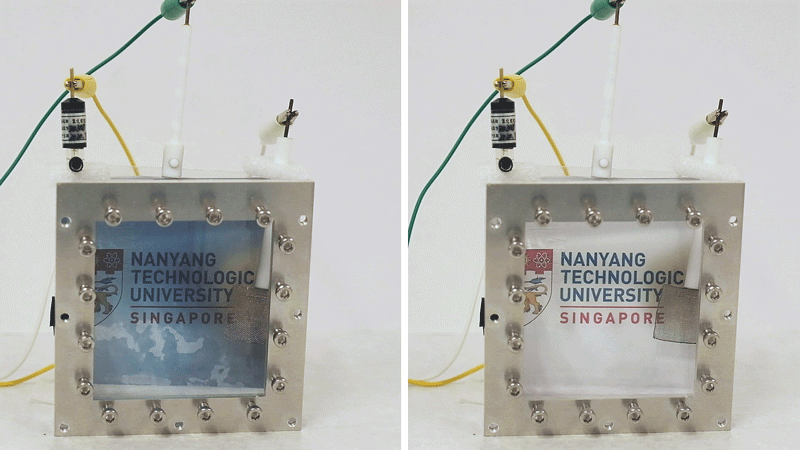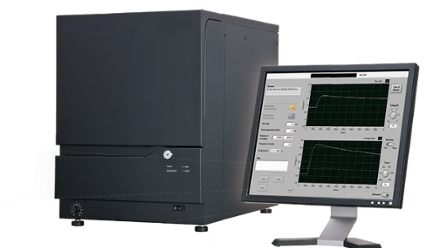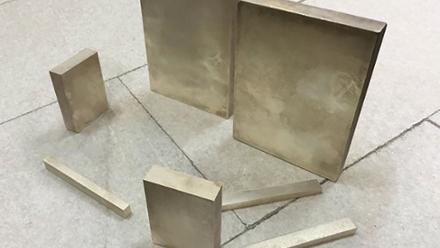Switching off heat transmission in electrochromic windows
A smarter material for electrochromic (EC) windows could help control heat transmission without blocking views.

Electrochromic materials become tinted when an electrical voltage is applied. A team at Nanyang Technological University (NTU) Singapore set out to develop an EC material that also reduces the resources used for heating and cooling buildings. Current EC windows can only block visible light, not infrared radiation warming up the room.
‘[This] window blocks 70% of radiant heat passing through, and allows 90% visible light to pass through, even with the film and electrolyte,’ says Associate Professor Alfred Tok.
The scientists are developing the customised EC nanostructures from titanium dioxide (TiO2), tungsten trioxide (WO3), neodymium-niobium (Nd-Nb) and tin (IV) oxide (SnO2), along with a patented, energy-saving switch comprising magnetic carbon-based particles and thin films. When integrated into the EC material, the switch can control two types of heat transmission – infrared radiation and conduction heat.
In their paper, Nd−Nb Co-doped SnO2/ɑ-WO3 Electrochromic Materials: Enhanced Stability and Switching Properties published in ACS Omega, the researchers explain their choice of materials.
It reads, ‘Nb is a good dopant candidate for ECs owing to its ability to introduce active sites on the surface of ɑ-WO3 without causing much lattice strain due to the similar ionic radius of Nb5+ and W6+.
‘These active sites introduce more channels for charge insertion or removal during redox reactions, improving the overall EC performance. However, Nb suffers from prolonged utilisation due to lithium (Li) ions trapped within the ECs. By coupling Nd with Nb, the co-dopants would transfer their excess electrons to SnO2, improving the electronic conductivity and easing the insertion and extraction of Li+ cations from the ECs.’
To produce the material, the study reports that a regular array of polystyrene (PS) spheres are coated in an automated dip coating machine. A fluorine-doped tin oxide (FTO) substrate is dipped at a rate of 180mm.min−1 in a 0.2wt.% PS sphere suspension and kept for 90 minutes at 55°C.
The paper reads, ‘Inverse opal (IO) precursors were synthesised by dissolving by 2.8g of SnCl4·5H2O in 40mL of ethylene glycol (EG) under continuous stirring. Varying amounts of dopant precursors (NbCl5 and/or NdCl5·6H2O) were added to prepare different precursors…The precursors were kept at 200°C for 60 minutes.
‘The viscosity of the precursor was reduced by adding 80mL of ethanol to the cooled solution. The IO samples were prepared by dip coating the as-prepared PS opal onto the IO precursor solution. IO samples were dried at room temperature and heat-treated at 500°C for 120 minutes to obtain the Nd−Nb co-doped SnO2 IO.
‘...Lastly, the construction of the Nd−Nb co-doped SnO2/ɑ-WO3 EC structure was completed by electrodepositing the ɑ-WO3 precursor onto the IO samples. The as-fabricated ECs were washed and dried overnight at room temperature.’
The technology has been tested using a spectrophotometer, as well as temperature sensors to measure the specific wavelengths transmitted or reflected through the window.
The paper also reports that ‘high near-infrared (NIR) contrast (60% NIR modulation), rapid switching time (ɑ1s), and excellent stability – >65% of NIR modulation was retained after repeated electrochemical cycles’.
Tok adds, ‘The nanostructured film can be produced in large sizes, so it can be scalable in terms of size. In terms of manufacturing quantity, various standard window manufacturing processes are currently being studied to identify the most optimum scale-up process.’




